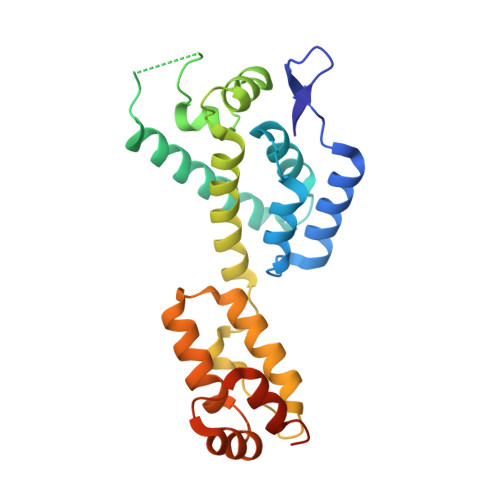Two structural switches in HIV-1 capsid regulate capsid curvature and host factor binding.
Stacey, J.C.V., Tan, A., Lu, J.M., James, L.C., Dick, R.A., Briggs, J.A.G.(2023) Proc Natl Acad Sci U S A 120: e2220557120-e2220557120
- PubMed: 37040417
- DOI: https://doi.org/10.1073/pnas.2220557120
- Primary Citation of Related Structures:
8CKV, 8CKW, 8CKX, 8CKY, 8CKZ, 8CL0, 8CL1, 8CL2, 8CL3, 8CL4 - PubMed Abstract:
The mature HIV-1 capsid protects the viral genome and interacts with host proteins to travel from the cell periphery into the nucleus. To achieve this, the capsid protein, CA, constructs conical capsids from a lattice of hexamers and pentamers, and engages in and then relinquishes multiple interactions with cellular proteins in an orchestrated fashion. Cellular host factors including Nup153, CPSF6, and Sec24C engage the same pocket within CA hexamers. How CA assembles pentamers and hexamers of different curvatures, how CA oligomerization states or curvature might modulate host-protein interactions, and how binding of multiple cofactors to a single site is coordinated, all remain to be elucidated. Here, using single-particle cryoEM, we have determined the structure of the mature HIV-1 CA pentamer and hexamer from conical CA-IP 6 polyhedra to ~3 Å resolution. We also determined structures of hexamers in the context of multiple lattice curvatures and number of pentamer contacts. Comparison of these structures, bound or not to host protein peptides, revealed two structural switches within HIV-1 CA that modulate peptide binding according to CA lattice curvature and whether CA is hexameric or pentameric. These observations suggest that the conical HIV-1 capsid has different host-protein binding properties at different positions on its surface, which may facilitate cell entry and represent an evolutionary advantage of conical morphology.
- Department of Cell and Virus Structure, Max Planck Institute of Biochemistry, Martinsried 82512, Germany.
Organizational Affiliation:

















